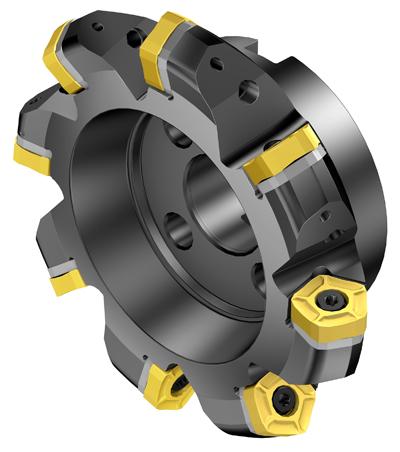
Sandvik Coromant introduces CoroMill 357, a new tough multi-edge face milling cutter for roughing and cubing in steel and cast iron with high insert security. In typical applications, such as rough face milling, cubing, intermittent component figurations, components with uneven stock or forgings, welding and castings, applying CoroMill 357 achieves a high metal removal rate and superior productivity.
The CoroMill 357 multi-edge design presents a cost efficient solution because the double sided, thick pentagonal inserts housed in shim-protected tip seats provides superior production economy and reliable performance. The mill's secure, strong cutter body features an innovative insert clamping system that offers quick and easy insert indexing to save time. Large support-faces radially, axially and on the base prevent deformation and ensure consistent performance.
Suitable for ISO 50 and larger machines, CoroMill 357 takes a depth of cut up to 10mm (0.394") with a feed per tooth up to 0.7mm/z (0.0276"/z). CoroMill 357 is available in diameter sizes 100-315mm (4-10").
Contact Details
Related Glossary Terms
- depth of cut
depth of cut
Distance between the bottom of the cut and the uncut surface of the workpiece, measured in a direction at right angles to the machined surface of the workpiece.
- feed
feed
Rate of change of position of the tool as a whole, relative to the workpiece while cutting.
- gang cutting ( milling)
gang cutting ( milling)
Machining with several cutters mounted on a single arbor, generally for simultaneous cutting.
- milling
milling
Machining operation in which metal or other material is removed by applying power to a rotating cutter. In vertical milling, the cutting tool is mounted vertically on the spindle. In horizontal milling, the cutting tool is mounted horizontally, either directly on the spindle or on an arbor. Horizontal milling is further broken down into conventional milling, where the cutter rotates opposite the direction of feed, or “up” into the workpiece; and climb milling, where the cutter rotates in the direction of feed, or “down” into the workpiece. Milling operations include plane or surface milling, endmilling, facemilling, angle milling, form milling and profiling.
- milling cutter
milling cutter
Loosely, any milling tool. Horizontal cutters take the form of plain milling cutters, plain spiral-tooth cutters, helical cutters, side-milling cutters, staggered-tooth side-milling cutters, facemilling cutters, angular cutters, double-angle cutters, convex and concave form-milling cutters, straddle-sprocket cutters, spur-gear cutters, corner-rounding cutters and slitting saws. Vertical cutters use shank-mounted cutting tools, including endmills, T-slot cutters, Woodruff keyseat cutters and dovetail cutters; these may also be used on horizontal mills. See milling.

